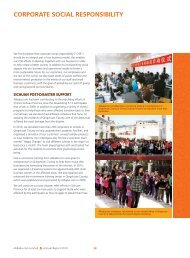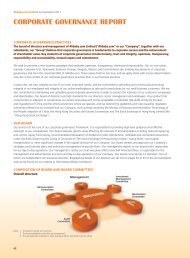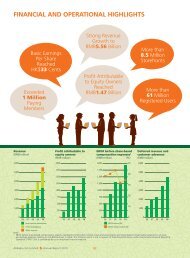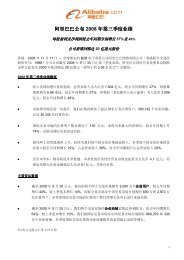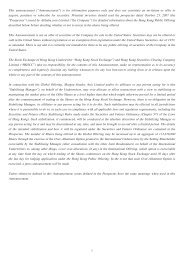Vision - Alibaba
Vision - Alibaba
Vision - Alibaba
Create successful ePaper yourself
Turn your PDF publications into a flip-book with our unique Google optimized e-Paper software.
2 SUMMARY OF SIGNIFICANT ACCOUNTING POLICIES (Continued)<br />
Notes to the Financial Statements<br />
2.6 Impairment of non-fi nancial assets<br />
Assets that have an indefi nite useful life are not subject to amortization, but are tested at least annually<br />
for impairment and are reviewed for impairment whenever events or changes in circumstances indicate<br />
that the carrying amount may not be recoverable. Assets that are subject to amortization are reviewed<br />
for impairment whenever events or changes in circumstances indicate that the carrying amount may<br />
not be recoverable. An impairment loss is recognized for the amount by which the asset’s carrying<br />
amount exceeds its recoverable amount. The recoverable amount is the higher of an asset’s fair value<br />
less costs to sell and value in use. For the purposes of assessing impairment, assets are grouped at<br />
the lowest levels for which there are separately identifi able cash fl ows (cash-generating units). Nonfi<br />
nancial assets, other than goodwill, that have suffered impairment are reviewed for possible reversal<br />
of the impairment at each reporting date.<br />
2.7 Other receivables<br />
Other receivables are recognized initially at fair value and subsequently measured at amortized cost<br />
using the effective interest method, less provision for impairment. A provision for impairment of other<br />
receivables is established when there is objective evidence that the Group will not be able to collect<br />
all amounts due according to the original terms of the receivables. Signifi cant fi nancial diffi culties of<br />
the debtor, probability that the debtor will enter into bankruptcy or fi nancial reorganization, and default<br />
or delinquency in payments are considered indicators that the other receivables are impaired. The<br />
amount of the provision is the difference between the other receivables’ carrying amount and the<br />
present value of estimated future cash fl ows, discounted at the original effective interest rate. The<br />
carrying amount of the other receivable is reduced through the use of an allowance account, and<br />
the amount of the loss is recognized in the income statement. When an amount of other receivables<br />
is uncollectible, it is written off against the allowance account for other receivables. Subsequent<br />
recoveries of amounts previously written off are credited to the income statement.<br />
2.8 Deferred costs<br />
Sales commissions paid in respect of service fees received in advance are deferred and are charged<br />
ratably to the income statement over the term of the respective service contracts as the services are<br />
rendered.<br />
2.9 Cash and cash equivalents<br />
Cash and cash equivalents include cash in hand, deposits held at call with banks, other short-term<br />
highly liquid investments with original maturities of three months or less.<br />
2.10 Share capital<br />
Ordinary shares are classifi ed as equity. Incremental costs directly attributable to the issue of new<br />
shares or options are shown in equity as a deduction, net of tax, from the proceeds.<br />
101





